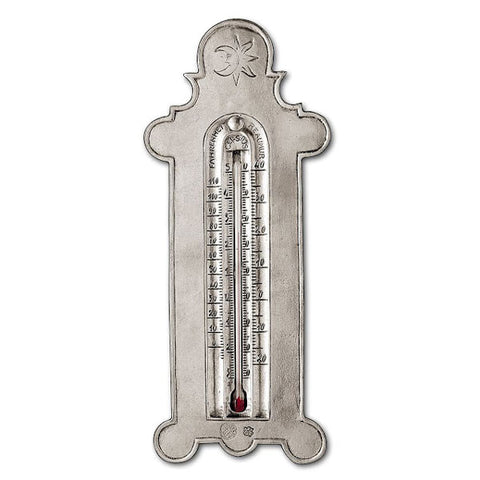Linneo 3 Scale Thermometer - 25 cm Height - Handcrafted in Italy - Pewter & Glass
This handcrafted pewter thermometer is a reverent reproduction of an ancient measuring instrument, bringing elegant classicism to your otherwise high speed digital day. This is the larger 'his' version of a related 'his' and 'hers' pair. The three classic scales of Fahrenheit, Réaumur and Celsius, make it even more interesting to gauge the temperature.
In 1593, Galileo measured room temperature using a glass cylinder containing alcohol, the density of which increased considerably when the temperature decreased. Glass balls of various densities with numbered tags attached to them floated in the liquid which rose or fell as it became more or less dense.
The scientists, students of Galileo, of the Cimento Academy in Florence, founded in the mid 17th Century, experimented with different kinds of thermometers and published their findings in a book, the Saggi di naturali esperienze fatte nell'Academia del Cimento sotto la protezione del Serenissimo Principe Leopoldo di Toscan e descrittedal segretario di essa Accademia usually referred to as the Saggi, which, due to the Academy's informal nature, was the only major publication, although the work undertaken there was highly respected.
In reality, rather than actually measuring temperatures, these early thermometers only indicated variations, so it is better to call them 'thermoscopes'. Thermoscopes were calibrated experimentally and the various scales could not be compared. However the beginnings of the thermometer were most definitely Italian; Santorio is said to have applied a scale to an air thermoscope as early as 1612 and thus is thought to be the inventor of the thermometer as a temperature measuring device. However, Santorio's instrument was an air thermometer, which meant its accuracy was poor, as the effects of varying air pressure on the thermometer were not understood at that time. Grand Duke of Tuscany, Ferdinand II produced, in 1654, the sealed liquid-in-glass thermometer, that is more familiar to us today. His thermometer had an alcohol filling and although his thermometer was a significant development it was still inaccurate and had no standardised scale for comparison.
The comparable thermometer was produced later, on the basis of certain fixed starting or finishing points (the temperatures of boiling water and melting ice). This led to three fundamental scales we are all familiar with: Fahrenheit, Réaumur and Celsius.
Fahrenheit, in 1714, was the first person to use mercury in a thermometer. Mercury expands more predictably; this, as well as improved glassworking techniques, meant the thermometer was more accurate than ever before. Fahrenheit divided the freezing and boiling points of water into 180 degrees. 32 was chosen as the the figure for the lower fixed point as this produced a scale that would not fall below zero even when measuring the lowest possible temperatures that he could produce in his laboratory - a mixture of ice, salt and water. Fahrenheit used the newly discovered fixed points to devise the first standard temperature scale for his thermometer. The Fahrenheit scale is still in use today.
Réaumur, in 1731, proposed a thermometer scale on which the freezing point of water was 0° and the boiling point was 80°. The Réaumur scale is seldom used today, although it is still used by some Italian and Swiss cheese manufacturers for measuring milk temperature, such as Parmigiano-Reggiano and Grana Padano cheeses, and also used in the Netherlands for cooking sugar syrup for desserts and sweets. Réaumur is still remembered as one of the key pioneers in developing the thermometer.
Then in 1742 Celsius devised a thermometer scale dividing the freezing and boiling points of water into 100 degrees. He chose 0 degrees for the boiling point of water, and 100 degrees for the freezing point. In 1743 Cristin sensibly inverted the Celsius scale, freezing point 0° and boiling point 100° to produce the Centigrade scale used today. Just over a century later, it was agreed that Cristin's adapted scale should be referred to as Celsius and is still in use today.
Cosi Tablellini pay respect to all of these pioneers producing this beautiful thermometer allowing one to measure the temperature on all three scales; Fahrenheit, Réaumur and Celsius.
Buying as a gift? Why not make it even more special with our engraving service?
Size: Height 25 cm
Weight: 230 g
Materials Used: Pewter, Glass
Ref: CT0089501
Designers: Enrico Cosi & Sergio Tabellini.
100% Lead Free
All Cosi Tabellini Pewter is 100% lead-free, so it is totally food & drink safe, and is both EU and US FDA approved.
Packaging
Cosi Tabellini pieces come gift-boxed with a guarantee card and instructions on how to care for pewter.


